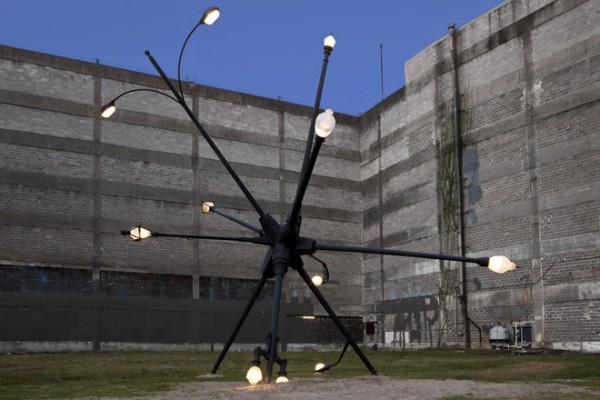Round Up: The Best of Prospect.2 New Orleans: Part 4: Satellites

Installation view of Michel de Broin's Majestic, 2011, at the intersection of Common Street and South Rampart Street in New Orleans. Courtesy the artist and The Third of May Arts Inc.
Michel de Broin
Curated and produced by The Third of May Arts Inc.
Lot at Common Street and South Rampart Street
October 22, 2011–January 29, 2012
From the looks of Majestic, a P.2 off-site sculptural installation, one could imagine its creator, Canadian artist Michel de Broin, stands some fifty feet tall. Only an enormous individual could have configured such an artifact. Majestic invites the fantasy that following the devastation of Hurricane Katrina, this gargantuan artist stretched out his mammoth hands, sweeping fallen streetlamps like Pixy Stix into his grip. With ingenuity and childish glee, the bases of the lamps were jammed together, welded by the tension into what resembles a stray piece from a game of jacks.
In reality, de Broin, whose work often flouts expectations of size and place, such as a 1,000-mirror disco ball hung above the Jardin du Luxembourg in Paris, conceived the work in Montreal and charged a team of local craftsmen to assemble it in New Orleans. The assemblage is comprised of ten working streetlamps, which illuminate the night, each differently shaped so that the history of design, as well as a narrative of New Orleans’ public works, is told in the aggregation. Resurrecting the post-Katrina discarded fixtures, de Broin reorganizes the systems of catastrophe and recovery. What has fallen has not merely been repaired, but reborn. Still it is the fictive vision that seems to describe the work best: the fifty-foot-tall artist with his creation in hand, sitting cross-legged with his back against Lee Circle’s massive pillar. With a single flick, the goliath sends his creation jacks-like skipping through New Orleans’ revitalized streets, crossing avenues and streetcar tracks before ultimately coming to rest in a vacant lot on the corner of Common and South Rampart.
—Adam Falik

Margot Herster, Earrings for Abdulaziz's mother, from Pictures from Home: For Abdulaziz, 2005/2011. C-print. Courtesy the artist.
Margot Herster
flexspace.2
638 Clouet Street
October 22, 2011–January 28, 2012
Margot Herster’s multifaceted exhibition works to humanize detainees at Guantanamo Bay. Contrary to the images of “scary, dangerous men” cultivated by mainstream media and the U.S. security apparatus, Herster displays ephemera from touching long-distance correspondence between the inmates and their families. She also illuminates the intimate relationships between the detainees and their attorneys. Photos and testimonies obtained from the lawyers depict their trips to detainees’ home countries to deliver gifts and messages. Each testimony is displayed on a notecard beside photos from the trip it describes. In one photo, a detainee’s three daughters hold the paper roses crafted by their father in his cell and sent with his lawyer on a visit to Yemen. Such images are displayed in confined, partitioned spaces in the front room of the gallery, suggesting the claustrophobia of a prison cell.
In the next room of the gallery, which is the ground floor of the artist’s renovated Bywater-chic home, Herster performs the roles of archivist and guide, showing visitors selected photos and documents from the legal proceedings and answering questions about what has become a six-year obsession for her. There are also several videos, whose audio tracks are sometimes cacophonous and distracting. The most prominent of these, on a lone television in a room with several comfortable couches, is a 14-minute clip of the detainees’ attorneys describing their involvement—both personal and professional—in the cases.
The images and testimony in the first room establish in subtle and compelling ways the complex dance Guantanamo inmates, their families, and their attorneys find themselves enacting. While the remainder of the exhibition falls flat—it feels both redundant and didactic in comparison—the show is well worth the visit for the initial component alone.
—Nathan C. Martin



